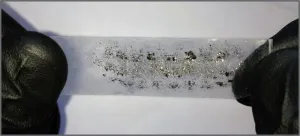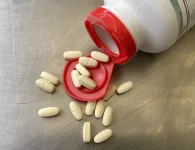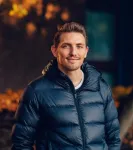(Press-News.org) By Rebekah Orton
Thomas Edison famously tried hundreds of materials and failed thousands of times before discovering that carbonized cotton thread burned long and bright in an incandescent light bulb. Experiments are often time consuming (Edison’s team spent 14 months) and expensive (the winning combination cost about $850,000 in today’s money).
Expenses and time increase exponentially when developing the quantum materials that will revolutionize modern electronics and computing.
To make quantum material discovery possible, researchers turn to detailed databases as their virtual laboratory. A new database of understudied quantum materials that has been created by researchers at Pacific Northwest National Laboratory (PNNL) provides an avenue to discover new materials that could power gadgets far more powerful than Edison’s lightbulb.
Beyond Edisonian trial and error
“We wanted to understand a general class of materials that have the same crystal structure, but different properties depending on how you combine and grow them,” said materials scientist Tim Pope. This class of materials, known as transition metal dichalcogenides (TMDs), contains thousands of potential combinations, each of which requires a weeks’ long reaction to grow flakes of material the size of glitter.
Making the material is only the first step in understanding what it can do. As PNNL computational scientist Micah Prange said, each flake is “really small, really delicate,” and quantum features will only emerge when studied at super-low temperatures. Essentially, “a whole research program could go into each flake.”
Despite the difficulty of creating and measuring them, each combination holds promise to dramatically improve electronics, batteries, pollution remediation, and quantum computing devices.
]Prange said you can think of the flakes as “fancier graphene with a richer phenomenology and more practical possibilities.” Tough, light, and flexible, graphene has been known as the material of the future, with uses in everything from aerospace to wearable electronics.
“The varied properties across this class of materials mean that as we better understand them, one of the combinations could be selected for a desired property and exactly paired to the ideal use,” said Pope, “or even a brand new application.”
Quantum material development of the future
Building the database began with PNNL’s Chemical Dynamics Initiative, an effort to use PNNL’s strength in data science to fill in knowledge gaps left by measurement challenges and experimental limitations.
These particular quantum materials are made by varying proportions of the 38 transition metals, like tungsten or vanadium, in combination with three elements in the sulfur family. They can also be grown in three different crystal structures, meaning there are thousands of potential combinations, all with distinct properties.
Using a type of modeling called density functional theory, the researchers computed the properties of 672 unique structures with a total of 50,337 individual atomic configurations. Before this research, there were fewer than 40 studied configurations, with only a rudimentary understanding of their properties.
“Models can work out the quantum mechanics of how atoms are arranged,” said Prange. “From this, you can say if the material will conduct electricity or be transparent or how hard the material will be to compress or bend.”
Using the database, PNNL’s researchers revealed striking differences in the electrical and magnetic behaviors between different combinations. Importantly, the researchers also found other trends as they varied the transition metal, including a new understanding of transition metal chemistry at the quantum level.
Quantum combinations for machine learning
“When the crystal structure was overlaid with the database, it matched perfectly,” said Pope, speaking of the PNNL-grown flakes that are beginning to validate the modeling results.
“The idea was really to develop a big data set of theoretical simulations so we could use data analytics to understand these materials,” said Prange. “The immediate value of the project is that we did enough different cases to efficiently use machine learning.”
The open-source dataset, published in Nature Publishing Group’s journal ‘Scientific Data,’ offers researchers a strong starting point for exploring relationships between initial structures and corresponding properties. With this information, they can downselect to specific materials for study.
“This project is one example of how we can use a large computational dataset to guide the experimental research,” said CDI Chief Scientist Peter Sushko, “Projects like this provide critical data to the machine learning community and could streamline materials development. It is exciting to think about what needs to be understood next to enable synthesis of these materials with atomic precision.”
The research was supported by the Chemical Dynamics Initiative at PNNL.
###
About PNNL
Pacific Northwest National Laboratory draws on its distinguishing strengths in chemistry, Earth sciences, biology and data science to advance scientific knowledge and address challenges in sustainable energy and national security. Founded in 1965, PNNL is operated by Battelle for the Department of Energy’s Office of Science, which is the single largest supporter of basic research in the physical sciences in the United States. DOE’s Office of Science is working to address some of the most pressing challenges of our time. For more information, visit https://energy.gov/science. For more information on PNNL, visit PNNL's News Center. Follow us on Twitter, Facebook, LinkedIn and Instagram.
END
When materials discovery glitters
Virtual laboratory opens possibility for machine learning to understand promising class of quantum materials
2023-06-14
ELSE PRESS RELEASES FROM THIS DATE:
Just add sugar: Research shows common antioxidant can be more beneficial through glycosylation
2023-06-14
New research shows that polyphenolic compounds, which are commonly found in fruits and vegetables, can be combined with sugar molecules to create potential life-saving drugs.
Polyphenols are a class of compounds found in many plant-based foods. Polyphenols help prevent cellular damage in the body and can help to prevent diseases such as cancer or heart disease. However, many of them do not dissolve in water, making it difficult to fully take advantage of their health benefits.
Biological Engineering Professor Jixun Zhan and his graduate students Jie Ren and Caleb Barton recently published a comprehensive ...
Dietary supplementation shown to improve nutrition biomarkers in study of older men
2023-06-14
CORVALLIS, Ore. – A six-month study of healthy older men demonstrated that daily multivitamin/multimineral supplementation had a positive effect on key nutrition biomarkers.
The research led by Oregon State University’s Tory Hagen and Alexander Michels also showed that the changes in nutrition status could have direct connections to cellular function, measured by the oxygen consumption of the study participants’ blood cells.
The findings, published in the journal Nutrients, suggest that supplementation may be a key tool to help people stay healthier as they age.
“Many older adults take ...
Remains at Crenshaw site are local, ancestors of Caddo, study finds
2023-06-14
Hundreds of human skulls and mandibles recovered from the Crenshaw site in southwest Arkansas are the remains of ancestors of the Caddo Nation and not foreign enemies, according to a new study published in the Journal of Archaeological Science.
Collaborating with the Caddo Nation in Oklahoma, researchers at the University of Arkansas and Arkansas Archeological Survey tested lead and strontium isotopes in the teeth of human remains and compared them to ancient animal teeth from several surrounding regions to determine that the 700-year-old human remains were local ...
The Viking disease can be due to gene variants inherited from Neanderthals
2023-06-14
Many men in northern Europe over the age of 60 suffer from the so-called Viking disease, which means that the fingers lock in a bent position. Now researchers at Karolinska Institutet, together with colleagues, have used data from over 7,000 affected individuals to look for genetic risk factors for the disease. The findings, which have been published in Molecular Biology and Evolution, show that three of the strongest risk factors are inherited from Neanderthals.
Up to 30 percent of men in northern Europe over 60 suffer from ...
Further hope for base-edited T-cell therapy to treat resistant leukaemia
2023-06-14
Three young patients with relapsed T-cell leukaemia have now been treated with base-edited T-cells, as part of a ‘bench-to-bedside’ collaboration between UCL and Great Ormond Street Hospital for Children (GOSH).
The data from the NHS clinical trial, published in The New England Journal of Medicine and funded by the MRC, shows how donor CAR T cells were engineered using cutting edge gene editing technology to change single letters of their DNA code so they could fight leukaemia.
The experience of using the cells in three patients is shared, and includes 13-year-old Alyssa from Leicester, who last year was the first person in the world to ...
A new way to visualize force-sensing neurons
2023-06-14
A recent study by researchers at Texas Children’s Hospital, Baylor College of Medicine, and Scripps Research Institute has discovered fluorescent dye FM 1-43 as an effective and versatile tool to visualize PIEZO2 ion channel activity in mechanosensory neurons. The study, published in Neuron, was led by Dr. Kara Marshall, assistant professor at Baylor College of Medicine and investigator at the Jan and Dan Duncan Neurological Research Institute at Texas Children’s Hospital, with Dr. Ardem Patapoutian, Nobel Laureate and professor at Scripps Research Institute.
Mechanosensation is the ability ...
Study finds that proven medications for alcohol use disorder are rarely given to adolescents and young adults on public insurance
2023-06-14
BOSTON – Heavy drinking commonly begins in adolescence and is a known risk factor for the development of alcohol use disorder (AUD). Data from adult clinical trials suggest offering evidence-based medications for AUD to younger adults could promote their engagement in treatment and improve clinical outcomes.
But are those medications being used when and where they are needed? In a review of claims data for youths insured by Medicated in 15 U.S. states, a team of researchers found that most youths with a diagnosis of AUD do not receive medications as part of their therapy, despite ...
Phosphate, a key building block of life, found on Saturn’s moon Enceladus
2023-06-14
An international team including a University of Washington scientist has found that the water on one of Saturn’s moons harbors phosphates, a key building block of life. The team led by the Freie Universität Berlin used data from NASA’s Cassini space mission to detect phosphates in particles ejected from the ice-covered global ocean of Saturn’s moon Enceladus.
Phosphorus, in the form of phosphates, is vital for all life on Earth. It forms the backbone of DNA and is part of cell membranes and bones. The new study, published June 14 in ...
Conflict in marriage less harmful for kids when dad keeps it constructive
2023-06-14
URBANA, Ill. — Conflict is unavoidable in all marriages. When it erupts in families with children, stressed or angry parents may take their pain out on the kids, projecting their anger or withdrawing emotionally or physically. In the worst cases, children’s socioemotional development can suffer. But the way parents, especially fathers, deal with marital conflict can make a difference to kids, according to a new study from researchers at the University of Illinois Urbana-Champaign.
“In the past, marital conflict ...
Ten ways to increase Latino participation in Alzheimer’s research from leaders in health equity science
2023-06-14
CHICAGO, June 14, 2023 -- Leaders in health equity have issued an urgent call to address the underrepresentation of U.S. Latinos in Alzheimer's and dementia clinical trials. Their recommendations are outlined in an article published online today by Alzheimer's & Dementia: Translational Research & Clinical Interventions.
“A call to address structural barriers to the representation of Hispanics/Latinos in clinical trials on Alzheimer's disease and related dementias: A micro-meso-macro perspective,” was led by first author María P. Aranda, ...
LAST 30 PRESS RELEASES:
Securing AI systems against growing cybersecurity threats
Longest observation of an active solar region
Why nail-biting, procrastination and other self-sabotaging behaviors are rooted in survival instincts
Regional variations in mechanical properties of porcine leptomeninges
Artificial empathy in therapy and healthcare: advancements in interpersonal interaction technologies
Why some brains switch gears more efficiently than others
UVA’s Jundong Li wins ICDM’S 2025 Tao Li Award for data mining, machine learning
UVA’s low-power, high-performance computer power player Mircea Stan earns National Academy of Inventors fellowship
Not playing by the rules: USU researcher explores filamentous algae dynamics in rivers
Do our body clocks influence our risk of dementia?
Anthropologists offer new evidence of bipedalism in long-debated fossil discovery
Safer receipt paper from wood
Dosage-sensitive genes suggest no whole-genome duplications in ancestral angiosperm
First ancient human herpesvirus genomes document their deep history with humans
Why Some Bacteria Survive Antibiotics and How to Stop Them - New study reveals that bacteria can survive antibiotic treatment through two fundamentally different “shutdown modes”
UCLA study links scar healing to dangerous placenta condition
CHANGE-seq-BE finds off-target changes in the genome from base editors
The Journal of Nuclear Medicine Ahead-of-Print Tip Sheet: January 2, 2026
Delayed or absent first dose of measles, mumps, and rubella vaccination
Trends in US preterm birth rates by household income and race and ethnicity
Study identifies potential biomarker linked to progression and brain inflammation in multiple sclerosis
Many mothers in Norway do not show up for postnatal check-ups
Researchers want to find out why quick clay is so unstable
Superradiant spins show teamwork at the quantum scale
Cleveland Clinic Research links tumor bacteria to immunotherapy resistance in head and neck cancer
First Editorial of 2026: Resisting AI slop
Joint ground- and space-based observations reveal Saturn-mass rogue planet
Inheritable genetic variant offers protection against blood cancer risk and progression
Pigs settled Pacific islands alongside early human voyagers
A Coral reef’s daily pulse reshapes microbes in surrounding waters
[Press-News.org] When materials discovery glittersVirtual laboratory opens possibility for machine learning to understand promising class of quantum materials







